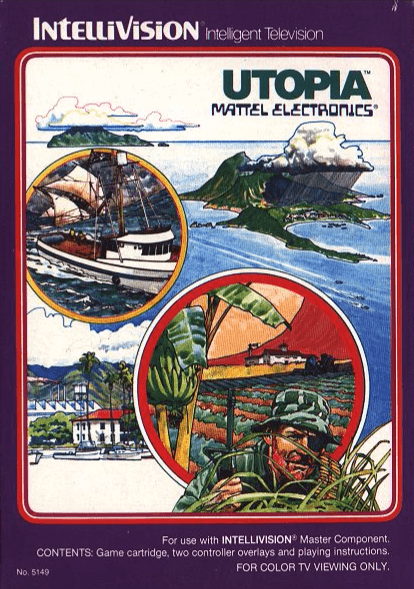
Well, as I was checking the news, I muttered “I am sure I could do better if I was in charge“. What do you know – shortly thereafter, I received a call. They asked me how long my mandate should be, and I said 10 years, minimum. After that, they asked me how long a year should be. Now that question puzzled me. When I asked for clarification, they told me “no less than 45 seconds“, so I said 60 seconds. And here I am now, trying to do better on Dan Daglow’s Utopia on Intellivision.
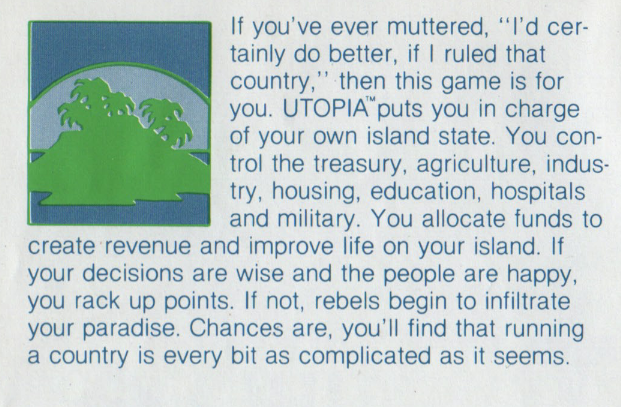
The game opens on this situation :
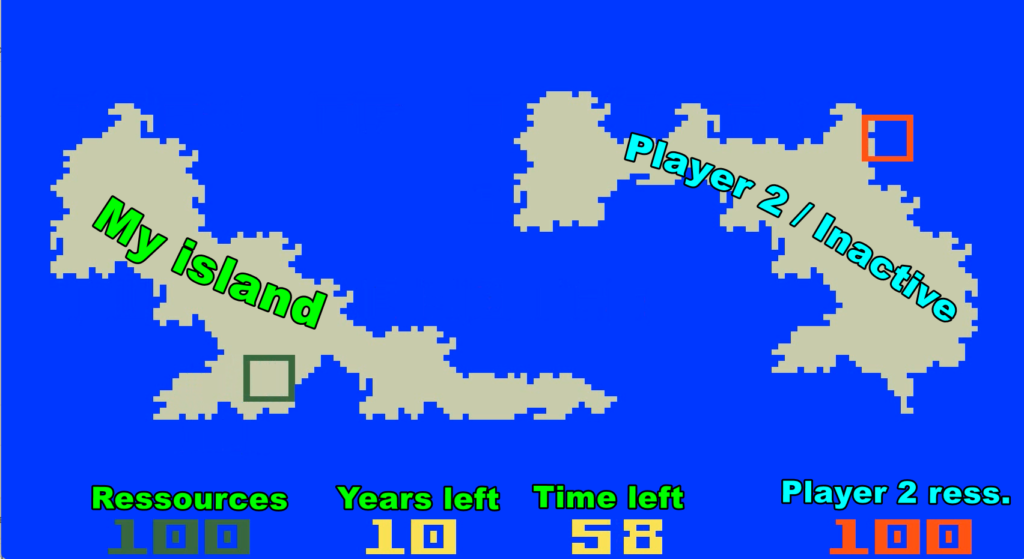
Utopia can be played as single-player or multiplayer. In multiplayer, the objective is obviously to outdo the other player, while in single-player, the objective is quite simply to score as many points as possible by “increasing the well-being of the people”. That’s what I am going to do.
Everything is pretty expensive in Utopia – think Switzerland, but as an island – so my first objective is to increase my revenue. After the initial allotment of 100 “gold bars”, there are 4 sources of revenue in the game :
- At the beginning of every year, the player gains 10 gold bars
- Farms (cost 3) bring 1 gold bar by second of rain on them, which often does not happen in a given year. Farms can disappear at the end of any year,
- Factories (cost 40) bring 4 gold bars by year. While they decrease happiness, they are more reliable than farms. The problem of course is that in theory it takes them 10 years to be profitable – and that’s before discounted interest. The trick is that some other buildings increase “productivity” and “well-being”, which can make factories a good choice,
- Finally, fishing boats (cost 25) bring 1 gold bar by year, but also one gold bar per second if the boat is manually driven above fishes.
As it is almost impossible to control more than one fishing boat at the same time, I build 1 fishing boat (cost 25), 1 factory (cost 40) and 1 school (cost 35) with my initial gold bar stock. I’ve listened to enough Pink Floyd to know that schools increase both productivity and happiness, so later I will be able to build more (profitable) factories.

After spending the rest of the first year fishing for a value of 17 gold bars, I start the following turn with 34 gold bars – which means the factory really brought me 6 gold bars. Meh. At least I also earn 37 points.
The following years are spent fishing more, and investing fishing revenue into more factories, into a couple of farms on the Eastern tip of my island, and into a second school, though the yearly revenue per factory seems to remain 6 whatever the number of schools.
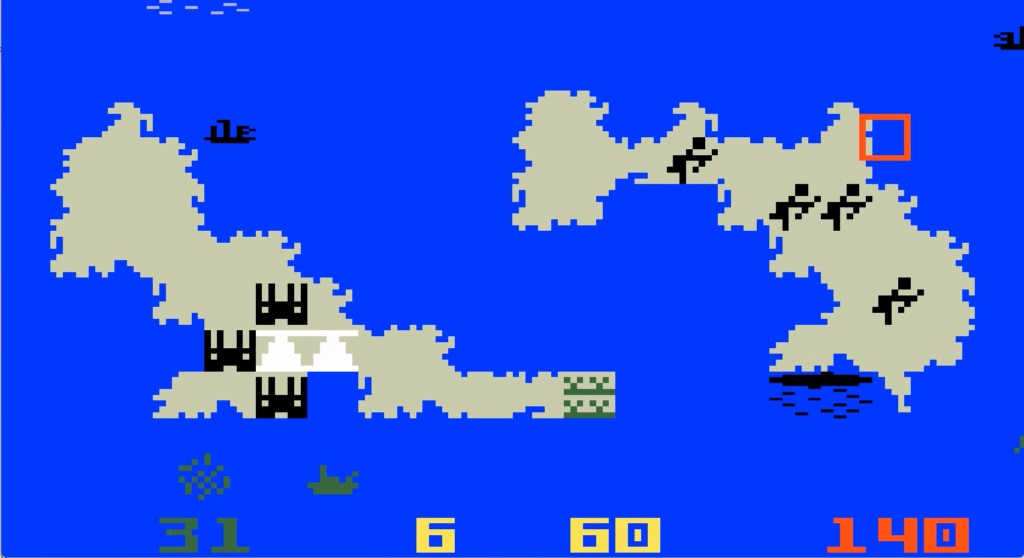
Fishing is always profitable, but the revenue can vary. Sometimes, the fishing grounds are on the edge of a screen (or below UI) and cannot be reached, sometimes pirates (the black ships) are dangerously close to my ship – if they touch it it is sunk.
Year 6, as some rain finally approaches my island, I abandon my fishing ship for a few seconds to build farms in front of the rain. Alas, the rain does not pass above my farms.
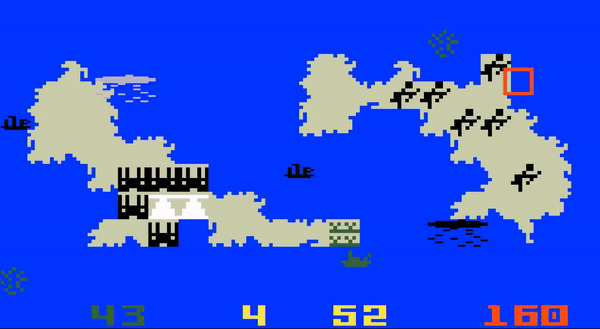
Shortly thereafter, as I am looking for more fish, a tornado passes through the middle of the map. Tornadoes can destroy absolutely anything, including buildings and pirate ships, but this one passes harmlessly.
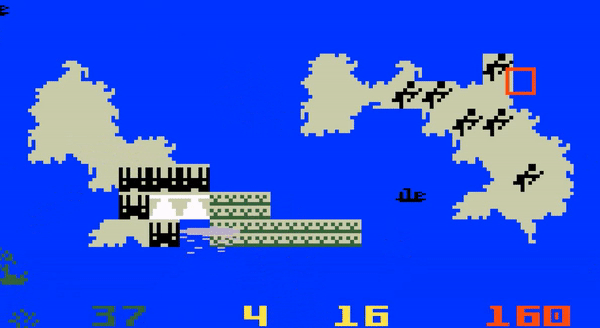
I carry on developing my island, building a hospital for 75 (more happiness and productivity) year 8, and a housing project for 600 (more population, which brings points provided they are also happy) year 9. The game ends at the end of the 10th year, and I have 595 points. I don’t know whether it is a good score or not.
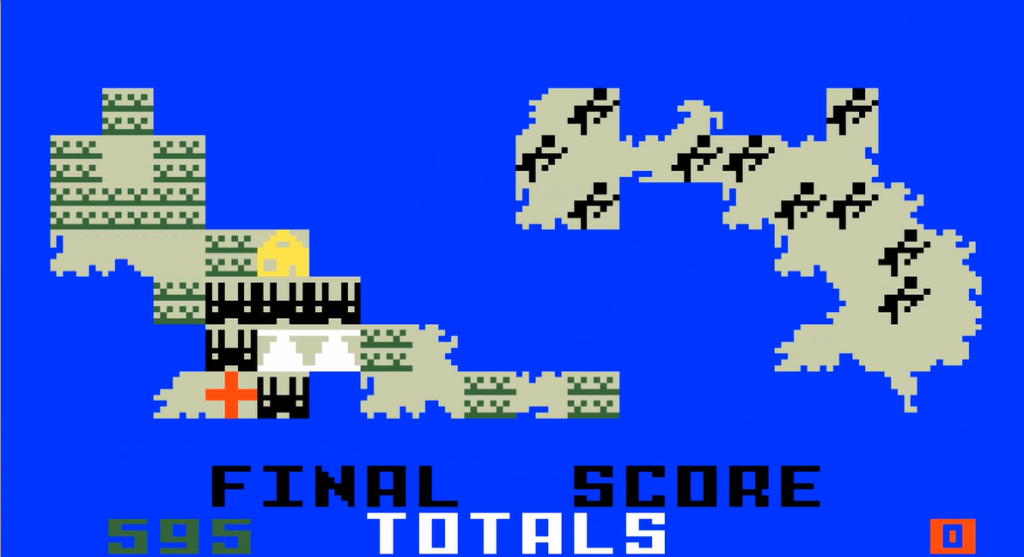
The only buildings you have missed because I was in single player where
- the fort (cost = 50, protects the buildings & ships surrounding it),
- the patrol boat (cost = 40, can be controlled like a fishing ship to block pirate ships and sink the other player’s fishing boats).
For 30, you can also spawn rebels on the other island. They can destroy a building by spawning (if these are not protected by a fort) and cost the other player happiness and points.
Utopia is a console game (for Intellivision), not a wargame and designed for two players so it should not have been within the scope of this blog. But it is also frequently mentioned as the ancestor of RTS, for instance in this article by Ars Technica or that one by VGChartz (in fairness that latter article also includes a long list of caveats). Paradoxically Retrogamer in this article claims the game is a precursor of turn-based strategy games like Civilization. Descriptions of Utopia‘s gameplay are always brief though, and for the purpose of an upcoming article I wanted to understand better how the game really played. It turns out that Utopia is not much of a RTS as we think of them now. The only real-time military action the player can do is to try to sink the other player’s fishing boats by touching them with their own PT boats, and if the bar to be considered a RTS is that low, then Utopia is far from the first : maybe Empire I and its successors do not qualify because they were real-time “with 5 seconds increment“, but I don’t see how one could exclude Galactic Attack (1980) and still consider Utopia a RTS.
What Utopia is is a real-time tycoon with arcade elements, a precursor to Sim City, not to Dune II, nor even to Civilization, even though it is sometimes dubbed Civilization 0.5. Just like in Sim City, the final objective is to grow your population and keep it happy, not to conquer the neighboring island – something not possible in the game. For this purpose, the game has several statistics, sadly often hidden from the player’s view : population (the game starts at 1 000), food supply (fishing ships and farms each produce food for 500 population), happiness (called “well-being”, increased by schools, hospitals and housing, decreased by factories and rebels), productivity and even maybe population growth. How these combine to calculate “points” each turn is sadly a mystery.
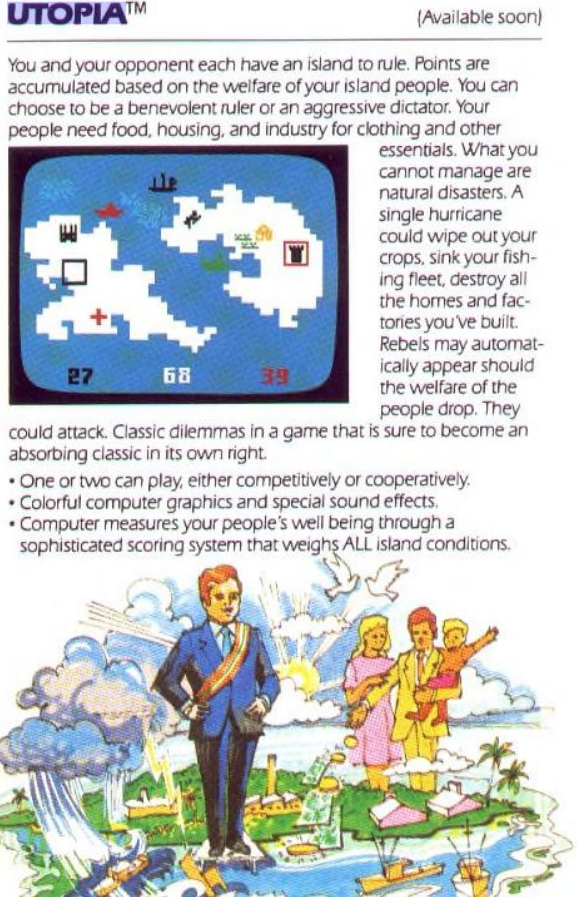
Neither Don Daglow nor Mattel expected much from the game as it did not seem to target a broad audience. Yet, the game attracted enormous attention at the January 1982 Consumer Electronic Show and after that sold, depending on the source, either well or exceptionally well – one site even claims (unsourced) 250 000 copies sold, which does not seem outlandish if you consider that there were 7 million Intellivision consoles sold. It is still today considered a groundbreaking game, worthy of various “Halls of fame” or “most influential” status, half of which were written by people who do not seem to have actually played the game.
As for Don Daglow, well, he had a few games behind him already in 1981 but his career was only starting. He would work on more than 30 games of all genres (including SSI Gold Box games, or Crawford’s Patton vs Rommel in 1987), and if this blog lasts long enough I will write about him again.
7 Comments
> I’ve listened to enough Pink Floyd to know that schools increase both productivity and happiness
Well, at least it helps put bricks on the walls, right?
HOW CAN YOU EAT YOUR PUDDING IF YOU DON’T EAT YOUR MEAT!!!!!????
Nobody who wrote about this game ever played it. Even the Youtube videos on it have people who clearly have no idea what they’re doing. They don’t feed their people with farms, they don’t house their people, they don’t start things off with a fort, they go for late game improvements like schools and hospitals.
Heck, even this playthrough only does 10 rounds, hardly enough to get out of the early game. 🙁
The problem is that playing the game as it was designed (in two players) is hard due to controls. The Intellivision was unique in that the controller was a numpad (+ 3 buttons), so in practice you need two keyboards plugged into your computer and some severe tweaking to make it work (assuming whatever emulator you use recognizes there are two keyboards).
So you have to play it alone, which makes forts (to protect your ship) and patrol boats pretty useless. And then, since there is no one to beat, making a long AAR is just going to be boring to read, so I just made my AAR long enough to showcase all buildings. That’s why it is a BRIEF and not a full-fledged article.
[…] [1981] often gets cited as the first RTS, or as the first God Game. The Wargaming Scribe has completely and comprehensively dismantled the case for it as the first RTS in just the past few […]
You didn’t mention it, but Intellivision controllers had a little plastic sheet you slipped over the numpad to show what it is each button did. And that was absolutely vital for games like this one where what each button did was a mystery otherwise. In general it was a pretty good controller, though as you noted, a pain to emulate. I don’t know if it was on PC, but Intellivision Lives did a good job of emulating that for PS2-era consoles.
That said, the game itself in two player mode is sort of like Monopoly, by the end of it, everyone is miserable and now hates each other. In single-player its nice, but quite a bit more relaxed compared to later simulation strategy games.
Atariage has a post from 2012 about Utopia where they disassembled the code and fully commented the logic. Search for “Utopia Revealed!”.
The economy and scoring are fairly sophisticated for an 8 bit game. Here are some of the details:
At the end of the round, you get awarded additional gold as follows.
Each of these contributes to the Round GDP except for the “baseline
10 bars.”
– 4 gold bars per factory
– 1 gold bar per fishing boat
– Productivity bonus: ((Schools + Hospitals) * Factories) +
Hospitals, clamped to a maximum of 30 gold bars.
– 10 gold bars of baseline income (does not contribute to the
Round GDP).
The approval rating per turn had four components:
– Housing score: ((Houses * 500) / (Population / 100)) / 3. If
larger than 30, clamp it to 30.
– Per-capita GDP score: ((Round GDP * 100) / (Population /
100)) / 12. If larger than 30, clamp it at 30.
– Food supply score: (((Fishing boats + Crops) * 500) /
(Population / 100)) / 3. If this value is larger than 30, clamp it
to 30.
– General welfare score: 1 point for every school or hospital
Note that factories don’t decrease happiness in the game. They increase it, by contributing significantly to GDP.